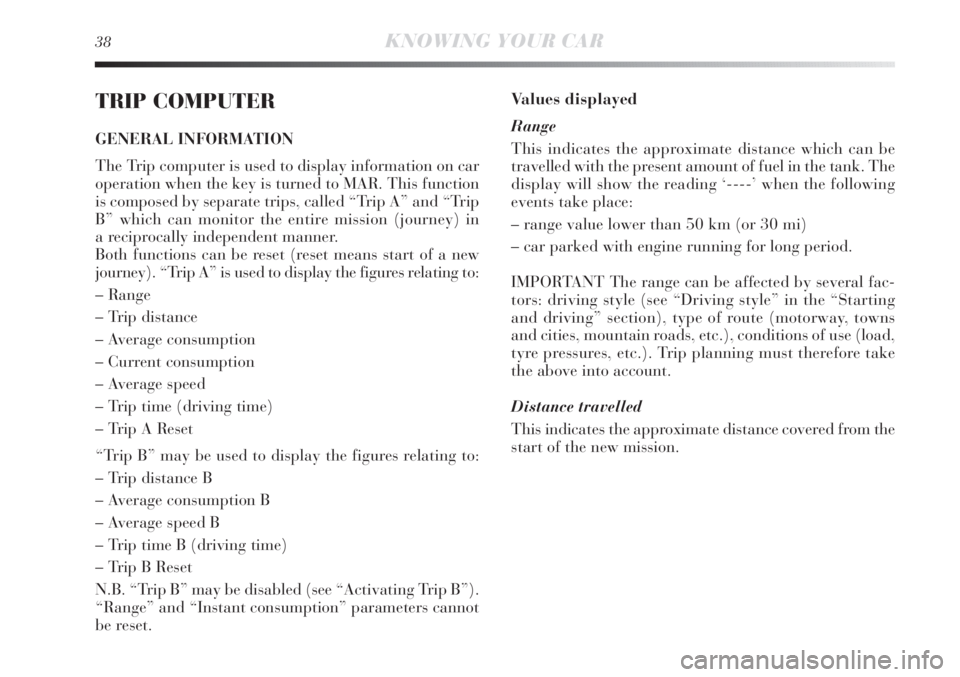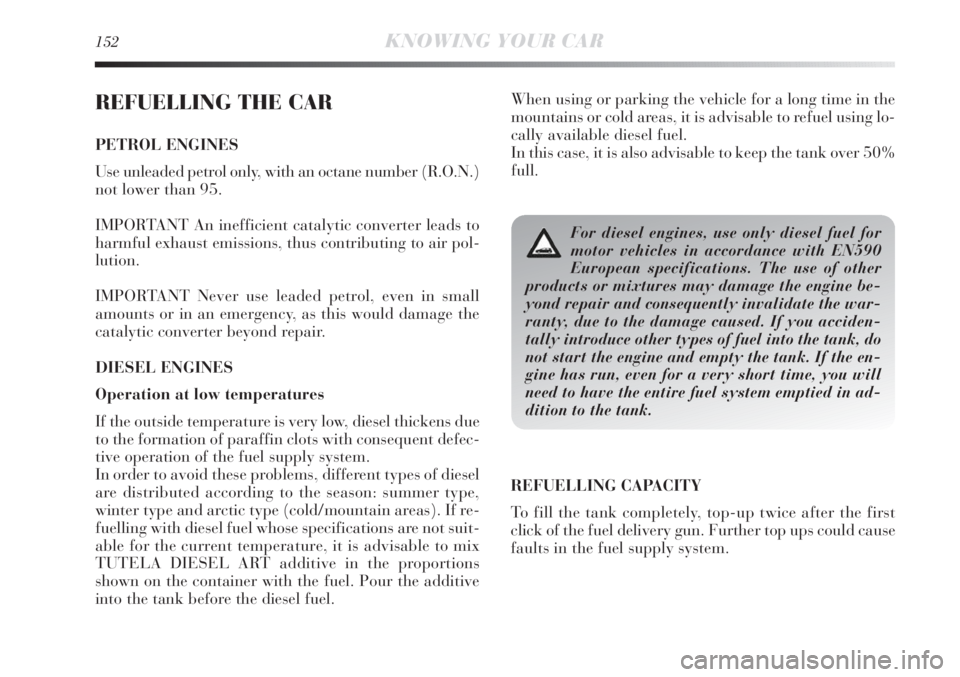tire type Lancia Delta 2012 Owner handbook (in English)
[x] Cancel search | Manufacturer: LANCIA, Model Year: 2012, Model line: Delta, Model: Lancia Delta 2012Pages: 295, PDF Size: 8.29 MB
Page 40 of 295

38KNOWING YOUR CAR
TRIP COMPUTER
GENERAL INFORMATION
The Trip computer is used to display information on car
operation when the key is turned to MAR. This function
is composed by separate trips, called “Trip A” and “Trip
B” which can monitor the entire mission (journey) in
a reciprocally independent manner.
Both functions can be reset (reset means start of a new
journey). “Trip A” is used to display the figures relating to:
– Range
– Trip distance
– Average consumption
– Current consumption
– Average speed
– Trip time (driving time)
– Trip A Reset
“Trip B” may be used to display the figures relating to:
– Trip distance B
– Average consumption B
– Average speed B
– Trip time B (driving time)
– Trip B Reset
N.B. “Trip B” may be disabled (see “Activating Trip B”).
“Range” and “Instant consumption” parameters cannot
be reset.Values displayed
Range
This indicates the approximate distance which can be
travelled with the present amount of fuel in the tank. The
display will show the reading ‘----’ when the following
events take place:
– range value lower than 50 km (or 30 mi)
– car parked with engine running for long period.
IMPORTANT The range can be affected by several fac-
tors: driving style (see “Driving style” in the “Starting
and driving” section), type of route (motorway, towns
and cities, mountain roads, etc.), conditions of use (load,
tyre pressures, etc.). Trip planning must therefore take
the above into account.
Distance travelled
This indicates the approximate distance covered from the
start of the new mission.
Page 154 of 295

152KNOWING YOUR CAR
REFUELLING THE CAR
PETROL ENGINES
Use unleaded petrol only, with an octane number (R.O.N.)
not lower than 95.
IMPORTANT An inefficient catalytic converter leads to
harmful exhaust emissions, thus contributing to air pol-
lution.
IMPORTANT Never use leaded petrol, even in small
amounts or in an emergency, as this would damage the
catalytic converter beyond repair.
DIESEL ENGINES
Operation at low temperatures
If the outside temperature is very low, diesel thickens due
to the formation of paraffin clots with consequent defec-
tive operation of the fuel supply system.
In order to avoid these problems, different types of diesel
are distributed according to the season: summer type,
winter type and arctic type (cold/mountain areas). If re-
fuelling with diesel fuel whose specifications are not suit-
able for the current temperature, it is advisable to mix
TUTELA DIESEL ART additive in the proportions
shown on the container with the fuel. Pour the additive
into the tank before the diesel fuel.When using or parking the vehicle for a long time in the
mountains or cold areas, it is advisable to refuel using lo-
cally available diesel fuel.
In this case, it is also advisable to keep the tank over 50%
full.
For diesel engines, use only diesel fuel for
motor vehicles in accordance with EN590
European specifications. The use of other
products or mixtures may damage the engine be-
yond repair and consequently invalidate the war-
ranty, due to the damage caused. If you acciden-
tally introduce other types of fuel into the tank, do
not start the engine and empty the tank. If the en-
gine has run, even for a very short time, you will
need to have the entire fuel system emptied in ad-
dition to the tank.
REFUELLING CAPACITY
To fill the tank completely, top-up twice after the first
click of the fuel delivery gun. Further top ups could cause
faults in the fuel supply system.
Page 201 of 295

IN AN EMERGENCY199
4
REPLACING A WHEEL
GENERAL INSTRUCTIONS
The car may be originally fitted with a space-saver wheel
(for versions/markets, where provided).
Wheel changing and correct use of the jack and spare
wheel call for some precautions as listed below.
The space-saver wheel (for versions/mar kets
where provided) is specific to your car, do not
use it on other models, or use the spare wheel
of other models on your car. The space-saver wheel
must only be used in case of emergency. Never use
it for more than strictly necessary and never exceed
80 km/h. On the space-saver wheel there is an or-
ange label, summarising the main warnings re-
garding space-saver wheel usage restrictions.
Never remove or cover the label. Never ap-
ply a hub cup on a space-saver wheel. The
following information is provided in four
languages on the label: IMPORTANT! FOR TEM-
PORARY USE ONLY! 80 KM/H MAX.! REPLACE
WITH STANDARD WHEEL AS SOON AS POS-
SIBLE. DO NOT COVER THIS LABEL.
If you change the type of wheel (alloy rims instead
of steel rims) you will have to change the entire set
of fastening bolts with another set of suitably sized
bolts.
Alert other drivers that the car is stationary
in compliance with local regulations: haz-
ard warning lights, warning triangle, etc.
Any passengers on board should leave the car, es-
pecially if it is heavily laden. Passengers should
stay away from on-coming traffic while the wheel
is being changed. If parked on a slope or rough sur-
face, chock the wheels with wedges or other suit-
able devices.